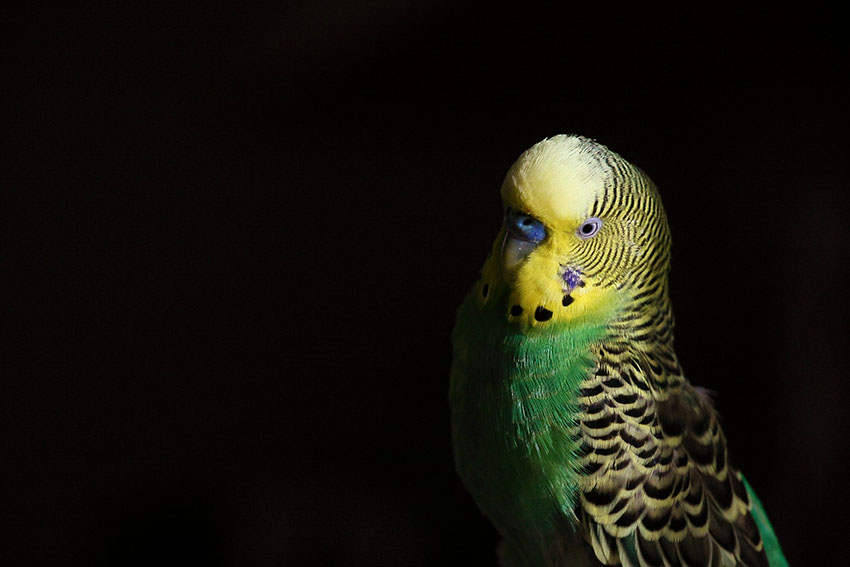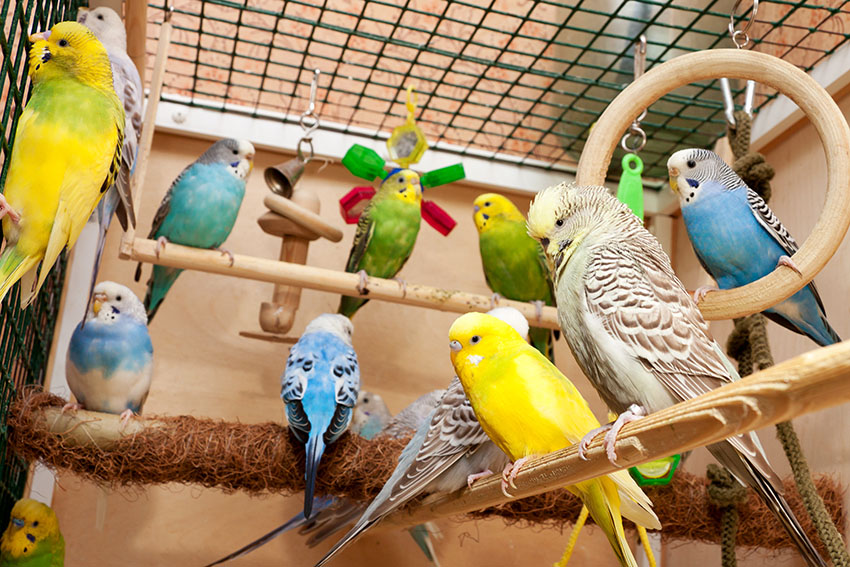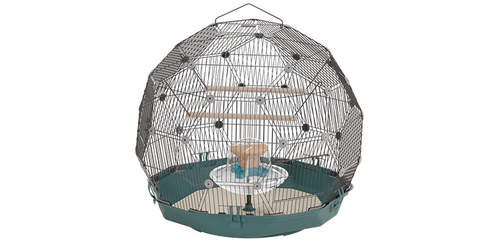There are many types of cage available, but not all of them have been designed with the needs of both the bird and the owner in mind. You need to combine sufficient space for the budgies with easy access for your hand, as you’ll be replenishing food and water every day and regularly cleaning the contents. Budgies need space to fly, and also require perches. A smaller cage might not give the bird room to exercise its wings properly, and with cheap, badly designed cages it’s often tricky getting food and water bowls in and out.
Budgerigar Cage Size
The minimum dimensions for a cage that will house single bird are 50x50x50cm (18.5 inches). Bigger is better, as budgies need space for horizontal flight. The bars should be closely spaced (not much more than 1cm apart) to prevent the bird from sticking its head out and possibly strangling itself, but perfect for gripping and climbing.
Budgerigar Cage Requirements
There should be nothing sharp in the cage, so check for any stray wires or ends of bars sticking out. This applies equally to the exterior, as your budgie, once finger-trained and able to leave the cage, will be exploring this area too. Any perch or toy you introduce should be without sharp edges or spikes, and should not have gaps into which a head or foot could be inserted but not easily retracted. It is also important to make sure the cage, and its contents, are not coated with a toxic paint or varnish. Anything showing signs of rust should be rejected too.
Budgerigar Cage Setup
A budgie will need several things in his cage: perches, feeding and drinking bowls, something to chew, a swing, some toys, a bird bath, and something to line the base of the cage. There’s lots more information on each of these budgie mod cons below.
Always remember that the cage isn’t just a convenience, it’s a fully equipped residence for a bird you are bringing home as a member of the family. Give your budgie the best!
Budgerigar Cage Stands
Budgie cages can be placed on any secure furniture, or you can buy a purpose-made stand. These can be elevated platforms, or stands that incorporate a hook for hanging the cage. You need to be practical – the cage must be secure, so never position the stand where it might be knocked (children, dogs and vacuum cleaners are all guilty here). It also needs to sit comfortably in its surroundings, so don’t go for the luminous white uPVC option if the rest of your furniture is antique wood.
Budgie Cage Cover
Whether or not you cover your budgie’s cage at night depends on where you live, and what the bird is used to. If your house or flat is in a busy area with lights being switched on and off all night or passing cars shining headlights through the gaps in the curtains, a cover will help the bird settle and get the regular sleep it needs – between 10 and 12 hours a night. The cover will also prevent your budgie from singing joyfully at dawn in the summer months, when, from a human perspective, sunrise doesn’t necessarily mean it’s time to get out of bed! You’ll need to remove the cover at a regular time each morning.
If the issues mentioned above don't apply to your home, a cover isn’t essential. In many ways it’s a good idea not to get the bird used to a cosy cover every night, as you will need to take it off at a regular time every morning, which could compromise those occasional weekend lie-ins. You’ll also be unable to cover and uncover the bird if you are away overnight (a single day away from home is something budgies can cope with).

A budgie needs to tell night from day
The important thing is to be consistent. If you’ve been covering the bird cage – or if the budgie was used to being covered before you bought it – carry on doing so. If the bird is sleeping at night (and you can check this by seeing if he sleeps during the day: if he does, he was probably disturbed during the night), and if he isn’t squawking you from your bed too early in the morning, don’t bother with a cover.
If you do cover the cage, use a plain, dark towel or sheet. You can also buy a cage-hugging cover from some pet shops, but these are very much an optional extra rather than a must-have.
Budgie Breeding Cage
If you keep lots of budgies, they will be in a large aviary rather than a cage. However, for breeding purposes budgie keepers sometimes isolate pairs in breeding cages with attached nesting areas. These are often multi-storey affairs, with separate compartments for each pair. There is more information on these cages, and how to set them up, in the Budgie Breeding section of this guide, below.
Budgie Cage Accessories

Happy budgies in a well-equipped birdhouse
Budgies like a bit of variety in their cages, and it will keep them alert and entertained if you change their toys around regularly. However, there are certain items that should be fixed features, including perches, swings, mineral blocks, and feeding and drinking apparatus. See the sections below for more details.




Comments
There are no comments just yet